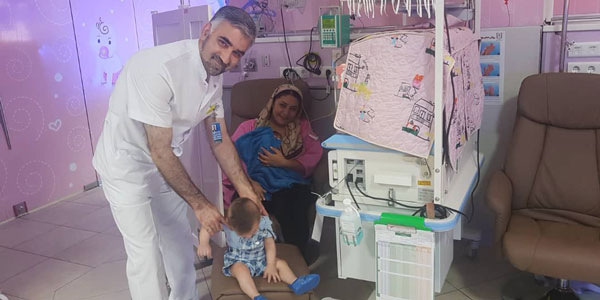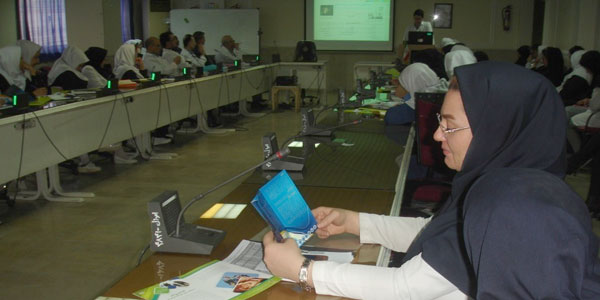Promoting informed consent in a children’s hospital in Tabriz, Iran: a best practice implementation project

Tabriz, the centre of East Azarbaijan province in Iran, is a scientific and medical hub in the northwest of the country that welcomes patients from neighbouring provinces.
Tabriz Children's Hospital is the only specialised and sub-specialised centre for children and infants in the northwest of the country. It creates a fresh, dynamic and safe environment with motivated professors and staff that provide comprehensive medical services to patients in all fields, such as blood and oncology, neurology, surgery, rare diseases in children, infants and adolescents under 14 years.

Informed consent is a serious issue in medical ethics. It involves patients obtaining comprehensive information about their health before making an autonomous decision about their care. This is considered a continuous and dynamic process rather than an isolated one. Informed consent becomes more complex in paediatric clinical practice, where parents must make decisions for their children.
Recently, the interest in informed consent has increased among medical professionals due to the development of new guidelines: ‘Every adult has the right to decide which treatment is recommended for him or her. Therefore, obtaining the consent of the patient or his/her legal guardians is necessary in all treatment methods, whether medical or surgical, except in emergency cases’, says Neda Kabiri from the Iranian Center of Excellence in Health Management at Tabriz University of Medical Sciences.
An audit conducted by the Hospital Quality Improvement Unit had shown that compliance with informed consent standards in the hospital was low. Multidisciplinary health professionals were complaining that no one was interested in or willing to take responsibility for obtaining informed consent. It was necessary to improve this process to protect the rights of patients and their parents by designing and conducting an intervention and informing physicians and nurses about the legal requirements of informed consent. The project was undertaken using JBI PACES software in the ear, nose and throat (ENT) and surgical wards of a children's hospital in Tabriz, Iran. The ENT ward has 30 beds and 32 nurses, and the surgical ward has 28 beds and 30 nurses.
The aim of the project was to evaluate current practice and implement best practice related to promoting informed consent in nursing and medical procedures, as well as surgical consent in the paediatric hospital. Following the JBI approach to evidence implementation, the first step was to establish a project team. An audit team (consisting of a lecturer, physician, nurse and PhD students in health policy; the quality control expert of the hospital; and research staff) reviewed the best available evidence related to informed consent.
The baseline audit criteria, which were derived from JBI evidence and translated to Persian by two of the researchers, included recommendations that:
1. Informed consent be obtained prior to all nursing procedures (that are not emergency situations) be documented.
2. The patient’s family be provided with information by staff related to alternative treatments.
3. The patient’s family be provided with information by staff related to the consequences of refusing treatment.
4. The patient’s family be provided with information by staff related to the nature and effect of the treatment.
5. The patient’s family be provided with information by staff related to the necessity of the treatment.

The team randomly selected 40 families of children with a hospital stay of more than one day who had signed the consent form to participate in the study. Results were analysed following the baseline audit to identify gaps between the current practice and the best practice recommendations. The results showed 38% compliance for criterion 2; 40% compliance for criterion 3; and 53% compliance for criterion 5.
Following the baseline audit, the Getting Research into Practice (GRiP) approach was followed to analyse barriers to evidence implementation, to determine strategies to address those barriers, to identify the resources required, and to document outcomes.
Identified barriers included the unwillingness of residents to obtain informed consent and the inattention of nurses in obtaining informed consent. The strategy for overcoming these barriers involved holding meetings with nurses, residents and heads of the two departments to encourage staff to report cases where informed consent was not obtained. Separate meetings were held with each group so that role-specific barriers and objections could be overcome with tailored strategies to motivate change.
Four months post-intervention, in October 2018, a follow-up audit was conducted that showed that the compliance rate of all criteria had improved. Providing information about alternative treatments and providing information relating to consequences of refusing treatment, which both had low baseline compliance, increased by 19% and 17%, respectively, to 57%. The follow-up audit also showed that compliance with providing information about the nature and effect of the treatment (criterion 4) improved from 53% to 74%.
’The follow-up audit results show that the intervention and strategies that we employed to improve informed consent can facilitate the implementation of evidence into clinical practice’, says Neda Kabiri.
The team identified common barriers to obtaining informed consent and made recommendations so that best practice in obtaining informed consent can be implemented more widely: ‘Common barriers in obtaining informed consent relate to communication between healthcare provider and patient, such as cultural and linguistic barriers and the patient’s level of education. To resolve these barriers and improve the quality of informed consent, informed consent should be included in medical students’ curriculum. Also, educating healthcare providers and creating hospital policies and strategies for obtaining informed consent would help overcome these barriers, as has been demonstrated in this project’, says Neda Kabiri.

Future plans include rolling the project out to other units to ensure that more patients with different types of diseases and surgeries are included. Also, further audits will be conducted to monitor practice and the effect of best-practice changes in the ENT and surgical wards.
Further Resources
Shah P, Thornton I, Turrin D, et al. Informed Consent. [Updated 2020 Aug 22]. In: StatPearls. Treasure Island (FL): StatPearls Publishing; 2020 Jan-. Available from: https://www.ncbi.nlm.nih.gov/books/NBK430827/
JBI Manual for Evidence Implementation (for GRiP approach)
Authors
Neda Kabiri1,2
Sakineh Hajebrahimi2,3
Gisoo Alizadeh1
Solmaz Azimzadeh1
Nayyereh Farajzadeh4
Amin Talebpour2,3
1. Iranian Center of Excellence in Health Management, School of Management and Medical Information, Tabriz University of Medical Sciences, Tabriz, Iran
2. Iranian EBM Centre: a JBI Centre of Excellence
3. Research Center for Evidence-Based Medicine, Health Management and Safety Promotion Research Institute, Tabriz University of Medical Sciences, Tabriz, Iran
4. Pediatric Hospital, Tabriz University of Medical Sciences, Tabriz, Iran
Disclaimer
Republished with permission from World Evidence-based Healthcare Day
https://worldebhcday.org/stories/story?ebhc_impact_story_id=93